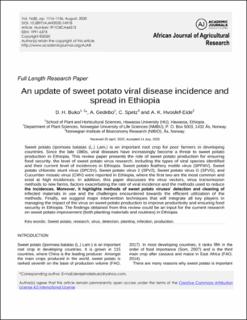| dc.description.abstract | Sweet potato (Ipomoea batatas (L.) Lam.) is an important root crop for poor farmers in developing countries. Since the late 1980s, viral diseases have increasingly become a threat to sweet potato production in Ethiopia. This review paper presents the role of sweet potato production for ensuring food security, the level of sweet potato virus research, including the types of viral species identified and their current level of incidences in Ethiopia. Sweet potato feathery mottle virus (SPFMV), Sweet potato chlorotic stunt virus (SPCSV), Sweet potato virus 2 (SPV2), Sweet potato virus G (SPVG), and Cucumber mosaic virus (CMV) were reported in Ethiopia, where the first two are the most common and exist at high incidences. In addition, this paper discusses the virus vectors, virus transmission methods to new farms, factors exacerbating the rate of viral incidence and the methods used to reduce the incidences. Moreover, it highlights methods of sweet potato viruses’ detection and cleaning of infected materials in use and the challenges encountered towards the efficient utilization of the methods. Finally, we suggest major intervention techniques that will integrate all key players in managing the impact of the virus on sweet potato production to improve productivity and ensuring food security in Ethiopia. The findings obtained from this review could be an input for the current research on sweet potato improvement (both planting materials and routines) in Ethiopia. | |
